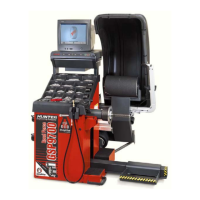70 4. Balancing a Wheel GSP9700 Series Road Force Measurement System Operation
Rim Safety Hump Design ‘Hangs Up’ Tire Bead During Bead Seating:
Some types of wheels use a square safety hump that may further inhibit uniform
tire bead seating. This further underscores the importance of proper lubrication
and bead seating procedures.
Temporary Flat Spotting:
Flat spotting may occur when the tire is in one position for an extended period of
time, such as a parked vehicle, improper storage of the tire, and temperature
extremes. Measurements for force and balance will stabilize as soon as the tire
is driven for a few miles. This important issue can also affect traditional wheel
balancing procedures.
Excessive Lateral Runout of Tire and/or Rim:
A tire or wheel with high lateral readings may affect the predicted results.
Do’s and Don’ts of Loaded Runout Measurement
Some tires may need to be warmed up to remove temporary flat spots prior to
testing.
Verify the wheel is centered before measurements are taken.
Use wing nut provided and it must be tight.
Tire inflation pressure must meet vehicle manufacturers specifications.
The tire/wheel assembly must be free of debris.
Bare rim runout measurements are required if the wheel design does not
permit external measurement of the outer bead seat area.
Use realistic Runout measurement values for the vehicle being tested.
If chosen values have been exceeded, never use Runout measurement alone
to warranty a tire unless specified by the manufacturer.
4.7 StraightTrak
®
LFM (Lateral Force Measurement)
StraightTrak
®
is an optional feature that corrects vehicle pull problems by suggesting
that the tires be placed at specific locations on the vehicle. If the vehicle being tested
has unidirectional tires, or different size tires front and rear, not all of the displayed
options will be valid.
Tire-related pulls are caused by lateral forces in the tires. Lateral force is the amount
of left or right pull force created as the tire rolls along the road. This condition may
cause a vehicle to steer away from straight ahead. These forces are primarily
created by conicity and cannot be detected during standard balancing or alignment
service.
The StraightTrak
®
LFM feature measures lateral tire force during the GSP9700's
“Road Force Measurement” test. The GSP9700 then applies this lateral force
information to a set of tires, providing the operator with multiple placement choices
about the vehicle. Tires are tagged and positioned on the vehicle to provide the least
amount of vehicle pull and obtain the best straight ahead steering stability. Pull or
drift caused by the lateral forces can be systematically minimized, offset or
eliminated.

